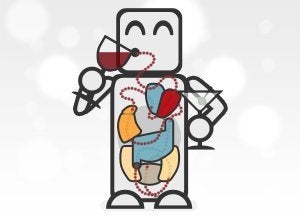
Most of us know that drinking too much can lead to car accidents, addictions or worse. We know drinking a little can make us giggly or weepy, lose our balance or lose our lunch, feel ravenously hungry the morning after or want nothing more than to be still in a dark room until that terrible pounding subsides.
But few of us know much more than the above, especially when it comes to what's actually going on inside the body to create these reactions.
In fact, alcohol, even in the smallest doses, affects nearly every system in the body, from the brain to circulation to immunity. And while at low to moderate doses, alcohol does seem to provide certain health benefits -- including a longer life and a healthier heart -- at higher doses, drinking carries with it the risk for long-term effects and permanent damage.
The holiday season in general -- and New Year's Eve in particular -- is rife with opportunities to drink alcohol -- and to overdo it.
In fact, those champagne toasts can come with some serious consequences. Two to three times more people die in alcohol-related car accidents during the week of Christmas and New Year's than other comparable time periods. During the rest of December, 28 percent of traffic-related deaths involve a drunk driver; that number jumps to 40 percent during the week of Christmas and New Year's. Visits to the emergency room for alcohol-related illness or injuries also increase on New Year's Day, by as much as two or 2.5 times.
Of course, you can responsibly toast to 2013. A standard drink is considered .6 ounces of pure alcohol, the equivalent of about 12 ounces of beer, eight ounces of malt liquor, five ounces of wine or 1.5 ounces of hard liquor, according to the CDC.
Experts typically define moderate drinking as one drink a day for women and up to two for men. Binge drinking is only a few rounds away; it's categorized as four or more drinks on a single occasion for women and five or more for men.
When it comes to being legally drunk, however, we measure alcohol consumption not by drinks, but by blood alcohol level or blood alcohol content (BAC), a measurement of the alcohol present in the blood. (Alcohol in the breath and urine mirrors the BAC.) The National Highway Traffic Safety Administration sets the legal definition of "drunk," as it pertains to driving impairment, at .08.
BAC is affected by gender, weight, how much and how recently you've eaten and how long you've been drinking, so it can be tricky to say how many drinks it takes to reach a given BAC. There are, however, some estimates and even online calculators that can approximate BAC, roughly.
While it's not an exact science, Aaron White, Ph.D. a health scientist administrator at the National Institute on Alcohol Abuse and Alcoholism (NIAAA), says intoxication is typically divided into three ranges. A low dose of alcohol would cause a BAC of up to .05. Anywhere from .06 to .15 would classify as a medium dose of alcohol, and a high dose would be anything above that.
Because the volume of water in the body directly affects BAC, experts recommend alternating between alcoholic drinks and non-alcoholic ones this New Year's Eve (and whenever multiple drinks might be on the menu). "It helps with the effects of dehydration, and, if you're holding a bottled water, it still gives you something to do with your hands," says Gary J. Murray, Ph.D., the acting director of the Division of Metabolism and Health Effects at the NIAAA.
Sources: National Institute on Alcohol Abuse and Alcoholism, Centers for Disease Control and Prevention, Johns Hopkins Bayview Medical Center
Graphic by: Chris Spurlock
Illustrations by: Troy Dunham